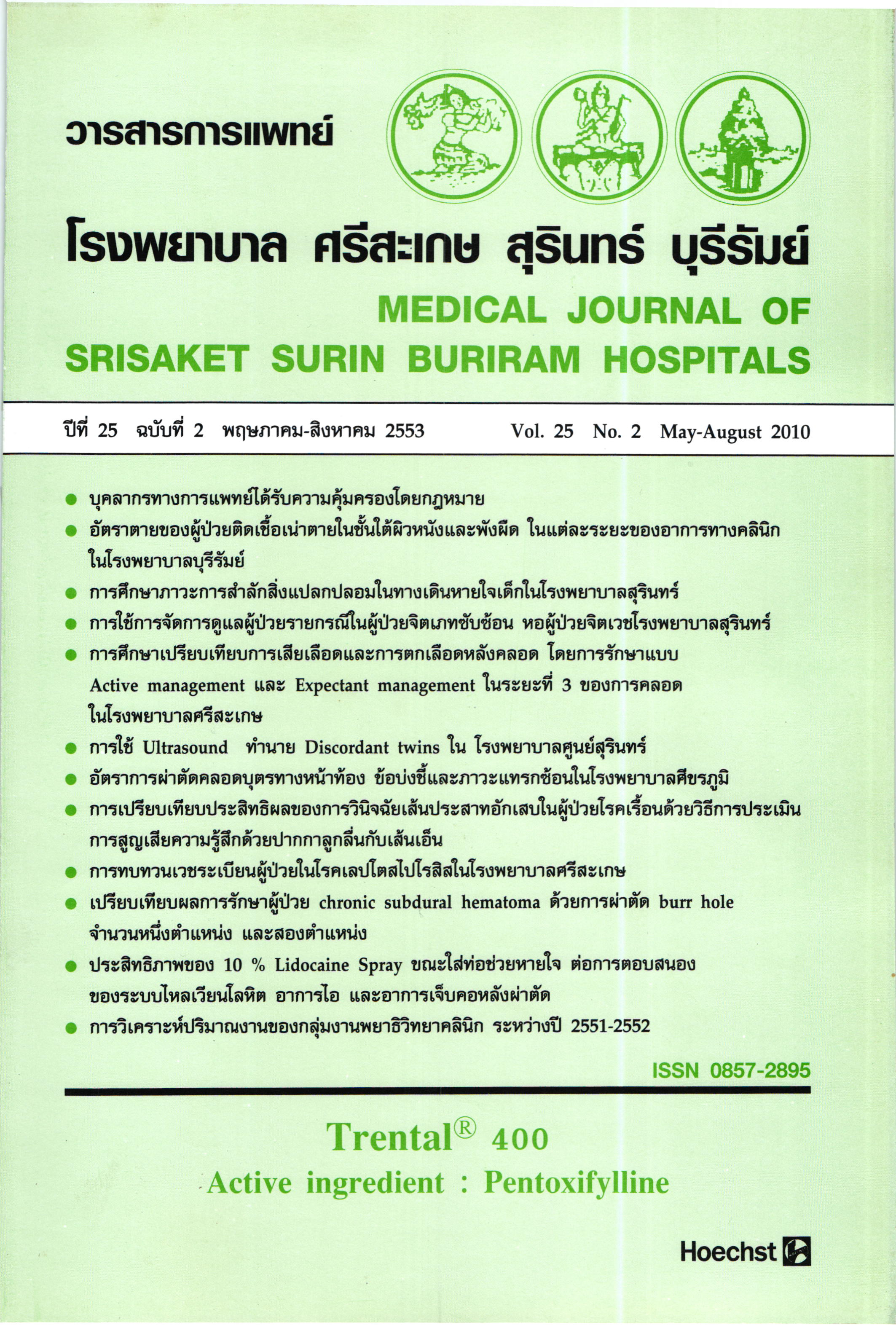การเปรียบเทียบประสิทธิผลของการวินิจฉัยเส้นประสาทอักเสบ ในผู้ป่วยโรคเรื้อนด้วยวิธีการประเมิน การสูญเสียความรู้สึกด้วยปากกาลูกลื่นกับเส้นเอ็น
Main Article Content
บทคัดย่อ
หลักการและเหตุผล: โรคเรื้อนเป็นโรคที่ทำให้เกิดความพิการได้ถ้าสามารถค้นหาเส้นประสาทอักเสบ และการเสื่อมและเสียหน้าที่ของเส้นประสาทส่วนปลายในระยะแรกและให้การรักษาได้เร็วทำให้ผู้ป่วยไม่เกิดความพิการเกิดขึ้น
วัตถุประสงค์: เพื่อเปรียบเทียบประสิทธิผลการทดสอบการสูญเสียความรู้สึกสัมผัสในผู้ป่วย โรคเรื้อนด้วยการใช้ปากกาลูกลื่น(Ball pen) กับการใช้เส้นเอ็น (Monofilament) เพื่อเปรียบเทียบทดสอบค้นหาความไว (Sensitivity) ในการค้นหาเส้นประสาท อักเสบและการเสื่อมและเสียหน้าที่ของเส้นประสาทส่วนปลายในระยะแรก
สถานที่ศึกษา: โรงพยาบาลบุรีรัมย์
รูปแบบการศึกษา: การศึกษาเซิงวิเคราะห์ที่ศึกษาทั้งเหตุและผลพร้อมกัน ณ จุดเวลาใดเวลาหนึ่ง
วิธีการศึกษา: การทดสอบความรู้สึกบริเวณฝ่ามือและฝ่าเท้าทั้ง 2 ข้างของผู้ป่วยโรคเรื้อนด้วย ปากกาลูกลื่น (Ball pen) และเส้นเอ็น (Monofilament) จำนวน 34 รายที่มาตรวจรักษาที่โรงพยาบาลบุรีรัมย์ตั้งแต่วันที่ 1 กรกฎาคม 2551 ถึงวันที่ 30 เมษายน 2553
ผลการศึกษา: ผลการทดสอบการสูญเสียความรู้สึกสัมผัสโดยใช้ Monofilament พบมีความไว ร้อยละ 47.06 ซึ่งสูงกว่าที่พบโดยการตรวจด้วย Ball pen (ร้อยละ 17.65) อย่างมีนัยสำคัญทางสถิติ (p=0.02) โดยประสิทธิผลและความไวของการทดสอบด้วย Monofilament สูงกว่าถึง 2.6 เท่า ของการทดสอบด้วย Ball pen การทดสอบด้วย Monofilament พบการสูญเสียความรู้สึกสัมผัสในบริเวณฝ่ามือ ที่เลี้ยงและควบคุมโดยเส้นประสาท Median, Ulnar และในบริเวณฝ่าเท้าที่เลี้ยง โดยเส้นประสาท Posterior tibial ใกล้เคียงกัน (ร้อยละ 33.35, 35.29 และ 38.34) ขณะที่การทดสอบด้วย Ball pen พบร้อยละ 5.55, 2.04 และ 8.82) ผู้วิจัยได้อภิปรายข้อมูลทั่วไปด้านผู้ป่วยและผลการทดสอบดังกล่าว และให้ข้อเสนอแนะในการประยุกต์ใช้ Monofilament test เป็นเครื่องมือสำหรับการตรวจ คัดกรองและติดตามความก้าวหน้าของการป้องกันและรักษาเส้นประสาทอักเสบ และการป้องกันความพิการในผู้ป่วยโรคเรื้อน โดยเฉพาะเพื่อแก้ปัญหาการวินิจฉัย และรักษาผู้ป่วยล่าช้า
สรุป: ประสิทธิผลและความไวของการทดสอบด้วย Monofilament สูงกว่าถึง 2.6 เท่า ของการทดสอบด้วย Ball pen
คำสำคัญ: โรคเรื้อน, โรคเห่อ, เส้นเอ็น (Monofilament), ปากกาลูกลื่น (Ball pen), ความพิการ, เส้นประสาทอักเสบ
Article Details
เอกสารอ้างอิง
ธีระ รามสูต. ตำราโรคเรื้อน. กรุงเทพมหานคร : โรงพิมพ์นิวธรรมดาการพิมพ์, 2535.
World Health Organization. A Guide to leprosy control, 2nd ed. Geneva: World Health Organization ; 1988.
World Health Organization. Chemotherapy of leprosy for control program. Geneva: World Health Organization; WHO Technical Report Services No.675.
ธีระ รามสูต. ความก้าวหน้าและข้อควร ปฏิบัติเกี่ยวกับการใช้ยาเคมีบำบัดโรคเรื้อน ผสมแบบใหม่ตามข้อเสนอแนะขององค์การ อนามัยโลก. แพทยสภาสาร, 2530;10:5-13.
ธีระ รามสูต. ปัญหาทางกังคมของโรคเรื้อน. วารสารกังคมศาสตร์การแพทย์, 2525; 5:69-81.
Bekri พ, Gebre S, Mengisite A, et al. Delay in presentation and start of treatment in leprosy patients : A case control study of clinical and non-disable patients in three different setting in Ethiopia. Int J Lepr, 1998; 66:1-9.
Linda M, Robert Son, Peter G Nicholls, Ruth Butlin. Delay in presentation and start of treatment in leprosy : experience in an out patient clinic in Nepal. Lepr Rev, 2000;71:511-516.
Da Silva Souza C, Bacha JT. Delayed diagnosis of leprosy and the potential role of educational activities in Brazil. Lepr Rev, 2003; 74:248-58.
Natasja HJ, Van Veen, Abraham Meima, Jan H Richardson. The relationship between detection delay and impairment in leprosy control : a comparison of patient cohort from Bangradesh and Ethiopia. Lepr Rev, 2006; 77:356-60.
Brandema W. Basic nerve function assessment in leprosy patients. Lepr Rev, 1981;52: 161-70.
van Brakel WH, Khawas IB, Gurung KE, et al. Intra and inter-tester reliability of sensibility testing in leprosy. Int J Lepr, 1996;64:287-98.
Gruener G, Dyck PJ. Quantitative sensory testing: Methodology, applications and future directions. J Clin Neurophysiol, 1994; 11:568-83.
Owen BM, Stratford CJ. Assessment of the methods available for testing sensation in leprosy patients in a rural setting. Lepr Rev, 1995;66: 55-62.
Bell-Krotoski JA, Weinstein S, Weinstein C. Testing, sensibility, including touch pressure, two-point discrimination, point localization, and vibration. J Hand Ther, 1993; 6:114-23.
Yamitsky D, Sprecher E. Thermal testing normative-data and repeatability for various test algorithms. J Neurol Sci, 1994:125:39-45.
Birke JA, Brandsma JW, Schreuders TA, Preffer A. Sensory testing with monofilaments in Hansen’s Disease and normal control subjects. Int J Lepr, 2000; 68:291-98.
Bell-Krotoski JA, Tomancik E. The repeatability of testing with Semmes-Weinstein monofilament. J HandSurg, 1987;12A:155-61.
Bell- Krotoski JA. ‘Pocket’ monofilaments and specifications for the Semmes-Weinstein monofilaments. J Hand Ther, 1990;3:26-31.
de Rijk AJ, Byass P. Field comparison of 10-g and 1-g filaments for the sensory testing of hands in Ethiopian leprosy patients. Lepr Rev, 1994;65:333-40.
Koelewijn LF, Meima A, Broekhuis SM, et al. Sensory testing in leprosy: comparison of ballpoint pen and monofilaments. Lepr Rev, 2003;74:42-52.
ILEP. The interpretation of epidemiological indicators in leprosy. London : The ILEP Medico. Social Commission, 2001.
Watson JM. Essential action to minimize disability in leprosy patients. London : The Leprosy Mission International, 1986.
Arunthathi S, Satheesh KK. Does clofazimine have a prophylactic role against neuritis? Lepr Rev. 1997; 68:233-41.
Ridley DS. Reactions in leprosy. Lepr Rev, 1969; 40:77-81.
Waters MFR, Turk JL, Wemambu SNC. Mechanisms of reactions in leprosy. Int J Lepr Other Mycobact Dis, 1999; 39:417-28.
Becx-Bleumink M, Berhe D, Mannetjie WT. The management of nerve damage in leprosy control services. Lepr Rev, 1990:61:1-11.
Lienhardt C, Fine PEM. Type-1 reaction, neuritis and disability in leprosy. What is the current epidemiological situation? Lepr Rev, 1994; 65:9-33.
Bell-Krotoski JA, Buford WL, Jr. The force-time relationship of clinically used sensory testing instruments. J Hand Ther, 1997;10:297-309.
Croff RP, Richardus JH, Smith wcs. The effectiveness of corticosteroids in the treatment of long term nerve impairment. Lepr Rev, 1997;68:316-25.
Girdhar A, Chakma JK, Ravinderan A, et al. A comparative study of high vs. Low dose corticosteroid therapy in reversal reactions in leprosy. Indian J Lepr, 2005;77:350-51.
Yamitsky D. Quantitative sensory testing. Muscle Nerve, 1997; 20:198-204.
Zaslansky R, Yarnitsky D. Clinical applications of quantitative sensory testing (QST). J Neurol Sci, 1998; 153:215-18.
Van Brakel WH, Nichollis PG, Das L, et al. The INFIR cohort study: assessment of sensory and motor neuropathy in leprosy at baseline. Lepr Rev, 2005; 76: 277-95.
Kumar A, Girdhar A, Girdhar BK. Nerve thickening in leprosy patients and risk of paralytic deformity : a filed based study in Agra, India. Lepr Rev, 2004 : 75: 135-42.
monofilaments Wim H. VAN BRAKEL et al. The INFIR Cohort Study : assessment of sensory and motor neuropathy in leprosy at baseline. Lepr Rev(2005) 76, 294.
การใช้ปลายปากกา เอกสารประกอบการประชุม โครงการพัฒนาบุคลากรด้าน สาธารณสุขระดับเขตและจังหวัด 16-19 สิงหาคม 2552 โรงแรมดุสิตปรนเซส นครราชสีมา


